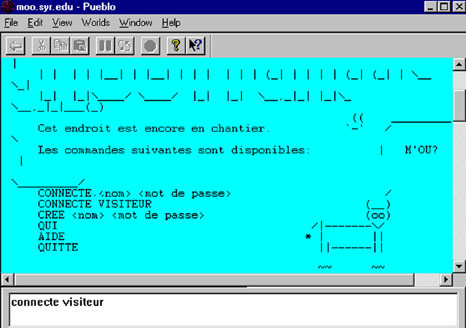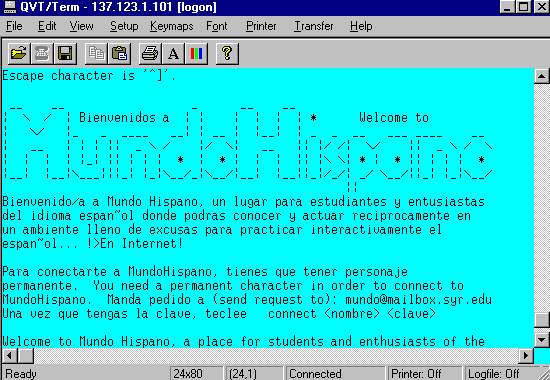
MOOs, MUDs, and MUSHes
MOO Activity
Remember that we defined these terms in
Objective #1 (MUDs: Multi-user domains; MOOs: MUDs, object-oriented; and
MUSHes: Multi-user Shared Hallucinations). Some people use these applications
for frivolous pastimes, but FL teachers would never do that. :-o
These applications, and MOOs in particular, can be fruitful language learning
and using experiences for our students. Several MOOs exist where native
speakers (NSs) and non-native speakers (NNSs) interact in the target language
(TL). Much like IRC, the communication in MOOs is effected via keyboard.
Participants "speak" by typing and "hear" by reading
the messages interchanged.
However, MOOs go much further and create
environments where people meet, mingle, converse, socialize, come and go.
Participants can move around in this virtual environment to different rooms
of a building, as well as locations outside their "home." Conversations
can be private or public and can include objects being exchanged, personal
notes passed, and the like. Some basic knowledge is necessary to begin
exploration: commands exist for operating in these virtual environments,
and they are generally intuitive.
To connect to a MOO (or a MUD or a MUSH),
you need a computer, a modem, and internet access with telnet capabilities.
The most direct way (no extra steps) is to connect by using raw telnet.
You just type the word "telnet" followed by the address given
for the MOO (MUD or MUSH) you want to access (see addresses below). When
using raw telnet, your screen will look something like this:
You can also connect to these virtual environments by using a client.
You will need to download and install whatever client program you choose.
Then just follow the instructions or menu for that client to connect to
your MOO (MUD or MUSH). A typical window when using a client for a MOO
might look like the one below. The client program used in this instance
is Pueblo.

Assignment
Go to one of the language MOOs listed below, log on as a guest1,
and experience the environment. Visit at least 3 times and spend at least
20 minutes each time investigating the MOO, learning your way around (literally
and figuratively!), and participating in TL conversation. Keep a journal
of your impressions of and experiences in the MOO. Later, you will be asked
to share your thoughts with the class. Try to envision using the MOO application
in your FL class. Some questions you might ask yourself are:
At what level would this be appropriate? What can I expect my FL students
to do in the MOO? Would participation in a MOO be helpful to my language
learners? Which students and under what circumstances?
You have one week to complete this assignment. If you get hooked, you
can also investigate MUDs and MUSHes, and some general information and
links are provided for you below.
1Some MOOs require that you have a permanent character and
use a password to log on. If this is the case, the opening message will
indicate how you can obtain a character name, make up and register your
own character name, and receive the password.
Foreign Language MOOs
Below are several different foreign language
MOOs, MUDs, and MUSHes. Some have a homepage associated with them, indicated
by a link. You might want to explore these additional sites before connecting
to the MOO, MUD, or MUSH.
MundoHispano
telnet europa.syr.edu 8888
or
telnet moo.syr.edu 8888
ArdaMOO, a Spanish language social MOO
telnet lince.las.es 7777
VCR MUSH: Virtual Classrooms MUSH. This MUSH consists of German, French,
Spanish and English sections.
telnet risky1.ssg.comp.uvic.ca 6250
Le MOO Francais, French langauge MOO
telnet moo.syr.edu 7777
Little Italy, Italian
language MOO
telnet little.usr.dsi.unimi.it 4444
MorgenGrauen LPmud, German
language MUD
telnet mud.uni-muenster.de 23
or
telnet mud.uni-muenster.de 4711
UNItopia, German language MUD
telnet infosgi.rus.uni-stuttgart.de:3333
MOOsaico, Portuguese language MOO
telnet moo.di.uminho.pt 7777
SvenskMud, Swedish language MUD
telnet svmud.lysator.liu.se 2043
schMOOze University
(an EFL/ESL MOO)
telnet schmooze.hunter.cuny.edu 8888
Latin: MUGIT at PennMOO
telnet ccat.sas.upenn.edu 7777
In addition to the sites above, the following pages provide more information
for those who are really into MOOs, MUDs, and MUSHes:
A Beginner's Guide
to MUSH will get you started. It also includes MUSH connection
information.
A helpful FAQ for MUD as well as descriptions of many clients to use
can be found at Jennifer Smith's MUDFAQ
page.
The Terradome page offers a MUD
guide for those interested in finding out about MUDs.
The MUD Resource Collection
, maintained by Lydia Leong, is a list of links to many useful sources
of MUD information.
[Learning the basics]

